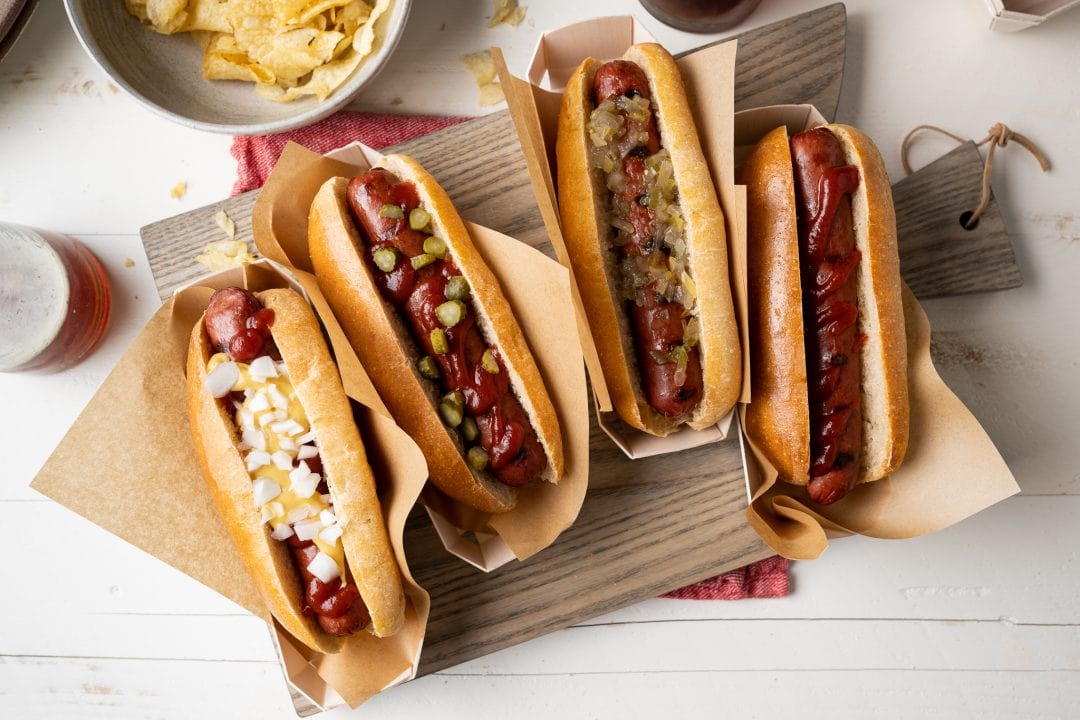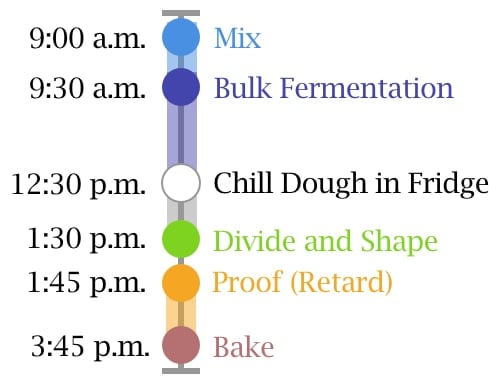Hot dogs fill a certain nostalgic sweet spot in my childhood. They remind me of summer days with prickly heat at the pool, birthday parties with water balloons and a slip ‘n slide, and the occasional get-together around a smoking hot grill just for the sake of it. While we never had homemade hot dog buns, our grill almost always had at least one pack of “American hot dogs,” as my grandmother used to call them. Sadly, the buns we did have for the delicious sausage were almost always a mass-produced bun that would invariably fail to hold up its end of the bargain. The flavorless vehicle was either dry and mealy or overly moist, apt to lose all structural integrity the minute ketchup was introduced. They were always an afterthought: the bread no one wanted but everyone needed.
Let's change course on the storebought hot dog bun. Instead, let's make our own sturdier version with loads more flavor and a light and airy texture.
In the past, I've experimented with making sourdough hot dog buns using my brioche hamburger bun recipe (a little too buttery) and my soft potato bun recipe (a little too soft) with good—but not great—results. Also, shaping the narrow tubes to accommodate hot dogs can be a little tricky if the dough is soft and tacky, which is usually the case with a dough destined for hamburgers (in my opinion, it's easier to shape a round shape versus an oval if the dough is sticky).
This recipe finds the right spot to satisfy; the homemade hot dog buns are airy yet sturdy, a touch buttery and sweet, and with deeper flavor thanks to the long fermentation time inherent with natural leavening—all from a dough that's much easier to handle.
An option: homemade New England hot dog buns
First, a note about regular hot dog buns versus New England hot dog buns: if you're familiar with the famed New England style buns, which are rectangular and the cut is on the top part of the bun, this recipe can be adapted to work in that way as well. These buns Are a little more rectangular in shape instead of the oval for other hot dog buns and are traditionally eaten with lobster rolls, crab rolls, and even clam rolls.
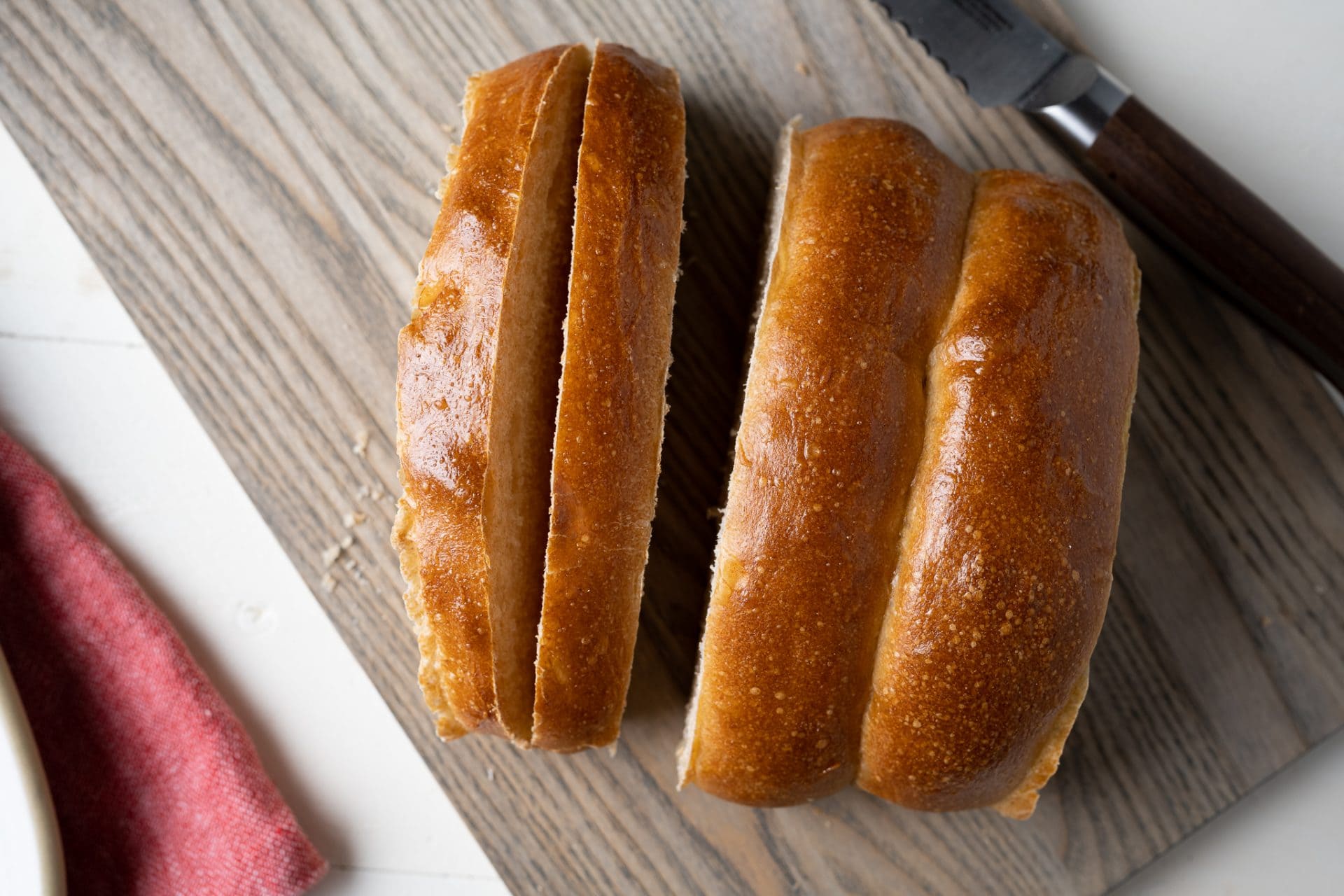
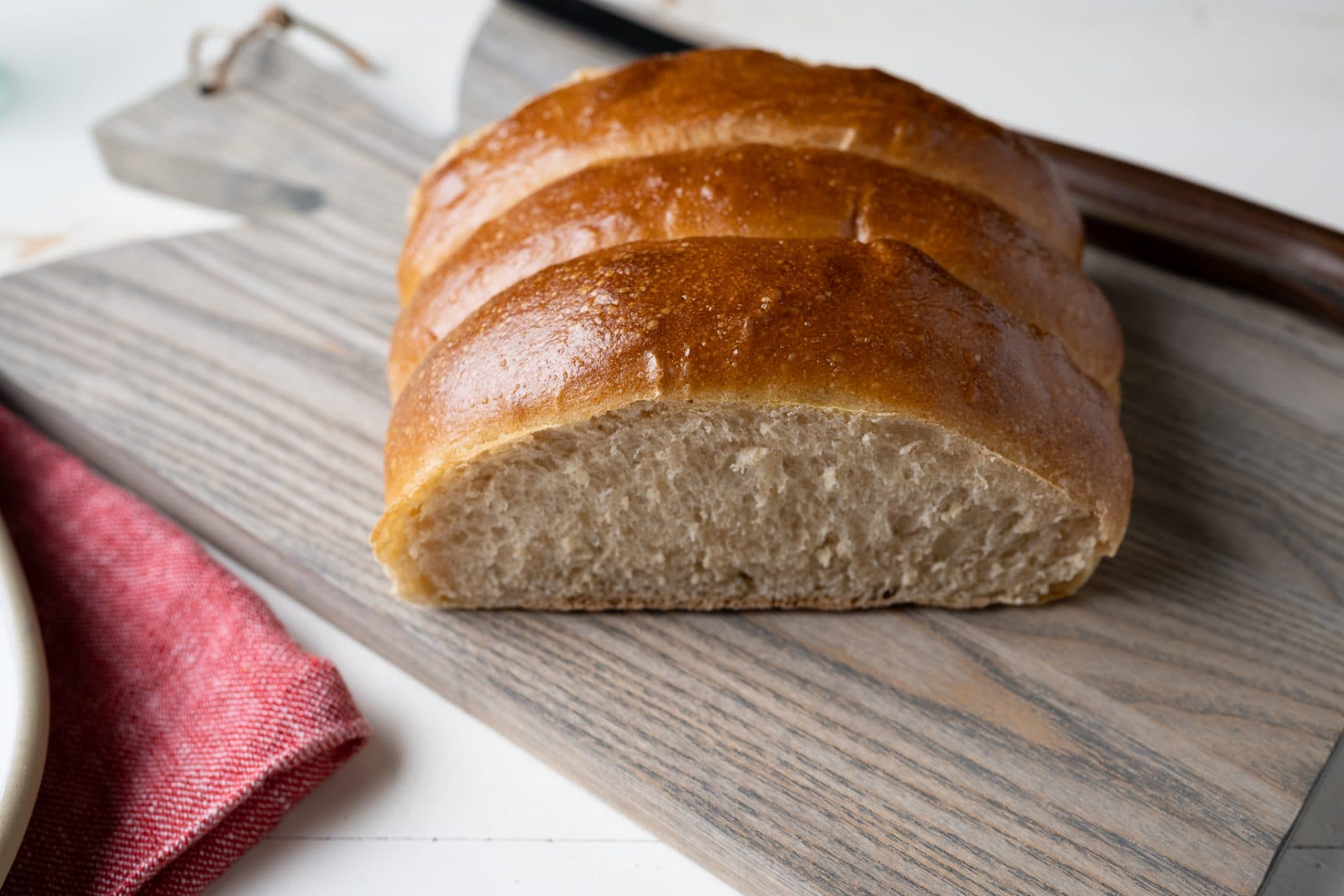
To adapt this recipe to make a New England-style hot dog bun, follow the recipe as directed, but instead of proofing them with space in-between on a half sheet pan, place them in a single row side by side (just about touching) in the middle of the same pan. As they rise during proofing, the dough will press against the pieces to the left and right, causing the entire thing to fuse and rise as one large rectangle.
Flour selection
Traditional hot dog buns are made with all white flour, but I like to work in 20% whole wheat into these buns. Using a mix of all-purpose white flour and whole wheat flour makes for a sturdier—and a little more healthy—bun. The whole wheat also brings additional flavor in terms of the flour itself and the additional organic acids created as a byproduct of fermentation.
If you don't want to use whole wheat in these buns, swap out the whole wheat flour for more all-purpose flour. Similarly, you could experiment with whole spelt flour (with perhaps a small reduction in hydration as necessary) or even a flavorful and nutritious type-85 flour.
Baking schedule
This is a straightforward recipe for those impromptu weekend grill sessions that always seem to pop up during the summer. There's no lengthy levain to make and no autolyse; use your ripe sourdough starter and mix it straight into a dough. The homemade hot dog buns will be ready for you in the later afternoon, just as the grill gets warm.
If you want to make these ahead of time, I suggest retarding the dough in bulk at the end of the called for 3-hour room temperature fermentation. Cover the bulk fermentation container with an airtight cover and place it in the fridge. The next day, remove the container and shape the dough as directed. Proof them on the counter until they're very soft and light, which could be 2 to 3 hours, temperature depending.
Homemade hot dog buns formula
Vitals
| Total dough weight | 1,050 grams |
| Sourdough starter in final dough | 28.00% |
| Yield | 10 x 100g hot dog buns |
Total formula
Desired dough temperature: 75°F (24°C). Check out my guide to dough temperatures for more information on the desired and final dough temperatures.
In addition to the ingredients below, you'll also need one whole egg and about a tablespoon of whole milk for the egg wash.
| Weight | Ingredient | Baker’s Percentage |
|---|---|---|
| 398g | Medium-protein bread flour or All-purpose flour (~11% protein, Central Milling Artisan Baker’s Craft or King Arthur Baking All-Purpose) | 80.00% |
| 100g | Whole wheat flour (Central Milling High Pro Fine or King Arthur Baking Whole Wheat Flour) | 20.00% |
| 274g | Water | 55.00% |
| 55g (one whole egg) | Egg | 11.00% |
| 50g | Butter, unsalted | 10.00% |
| 25g | Caster sugar | 5.00% |
| 9g | Fine sea salt | 1.90% |
| 139g | Ripe sourdough starter (100% hydration) | 28.00% |
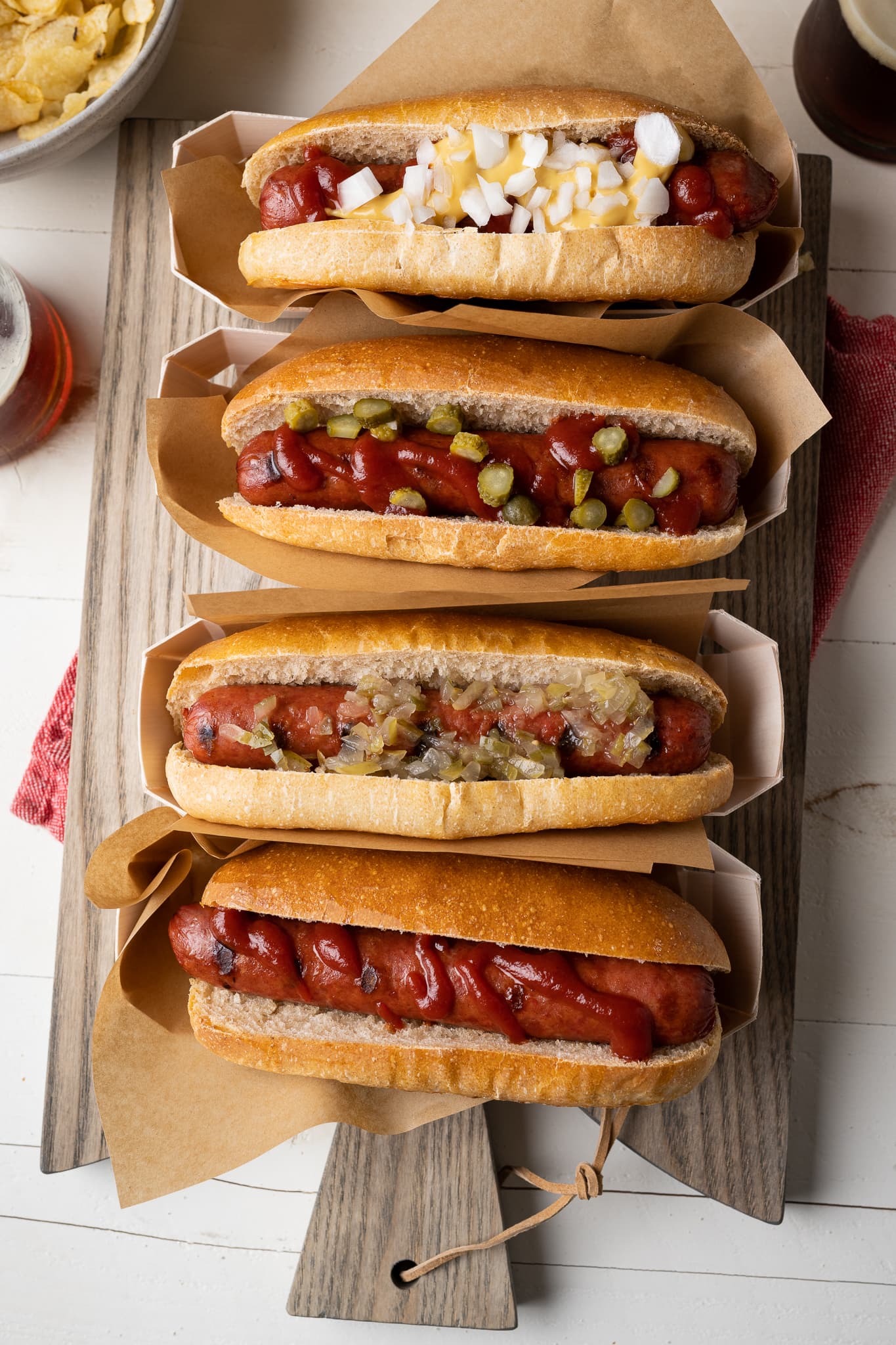
Oh, if you're curious about the swanky hot dog holders I have in the photo above, they're compostable wooden hot dog trays that hold your homemade sourdough hot dog bun, sausage, and all the fillings you could muster.
Homemade hot dog buns method
1. Mix – 9:00 a.m.
First, take out your butter and cut it into 1/2″ pats. Set the butter on a plate to warm to room temperature and reserve until the end of mixing.
To the bowl of a stand mixer fitted with the dough hook attachment, add the water, flour, sourdough starter, egg, sugar, and salt. Mix on speed 1 (STIR on a KitchenAid) for 1 to 2 minutes until the ingredients come together. Increase the mixer to speed 2 (2 on a KitchenAid) and mix for 4 to 5 minutes until the dough starts to strengthen and clump around the dough hook.
This dough doesn't need to be fully developed in the mixer, but it's better to mix longer than shorter—you want a strong dough before adding the butter. It won’t completely remove from the bottom of the bowl, and it will still be shaggy, but the majority of the dough should clump up around the dough hook.
Let the dough rest in the mixing bowl for 10 minutes.
Your butter should now be at room temperature; a finger will easily slide in and leave an impression. Turn the mixer on to speed 1 and add the butter, one pat at a time, waiting to add each pat until the previous one is fully absorbed. This is a fairly strong dough so it won't take long to add all the butter and for the dough to come back together and smooth, somewhere around 3 to 5 minutes.
Transfer the dough to a container for bulk fermentation and cover.
2. Bulk fermentation – 9:30 a.m. to 12:30 p.m.
At a warm room temperature, around 74-76°F (23-24°C), bulk should take about 3 hours. Give the dough three sets of stretches and folds at 30-minute intervals where the first set is 30-minutes into bulk fermentation. See my guide to stretching and folding dough during bulk fermentation for detail on this technique.
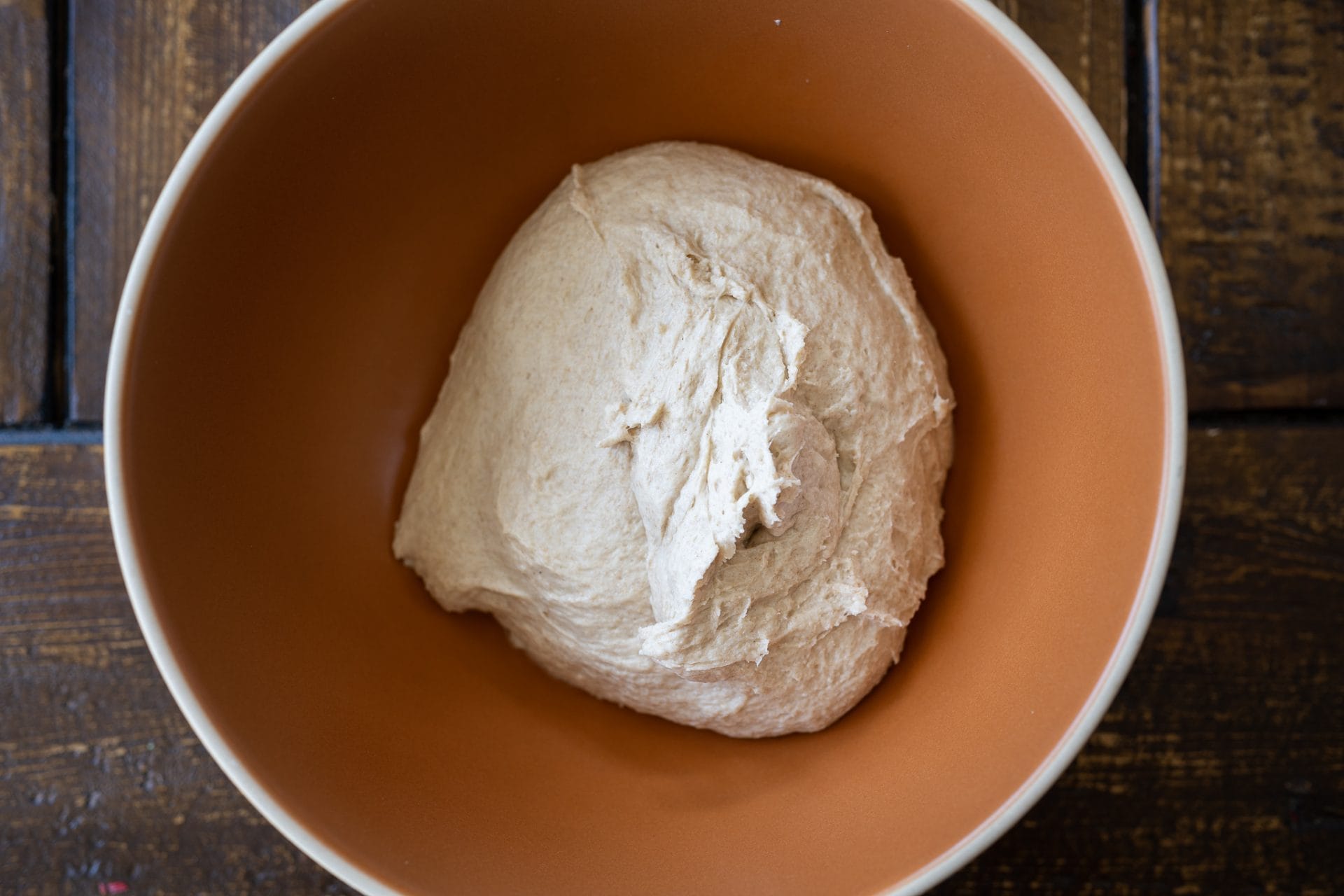
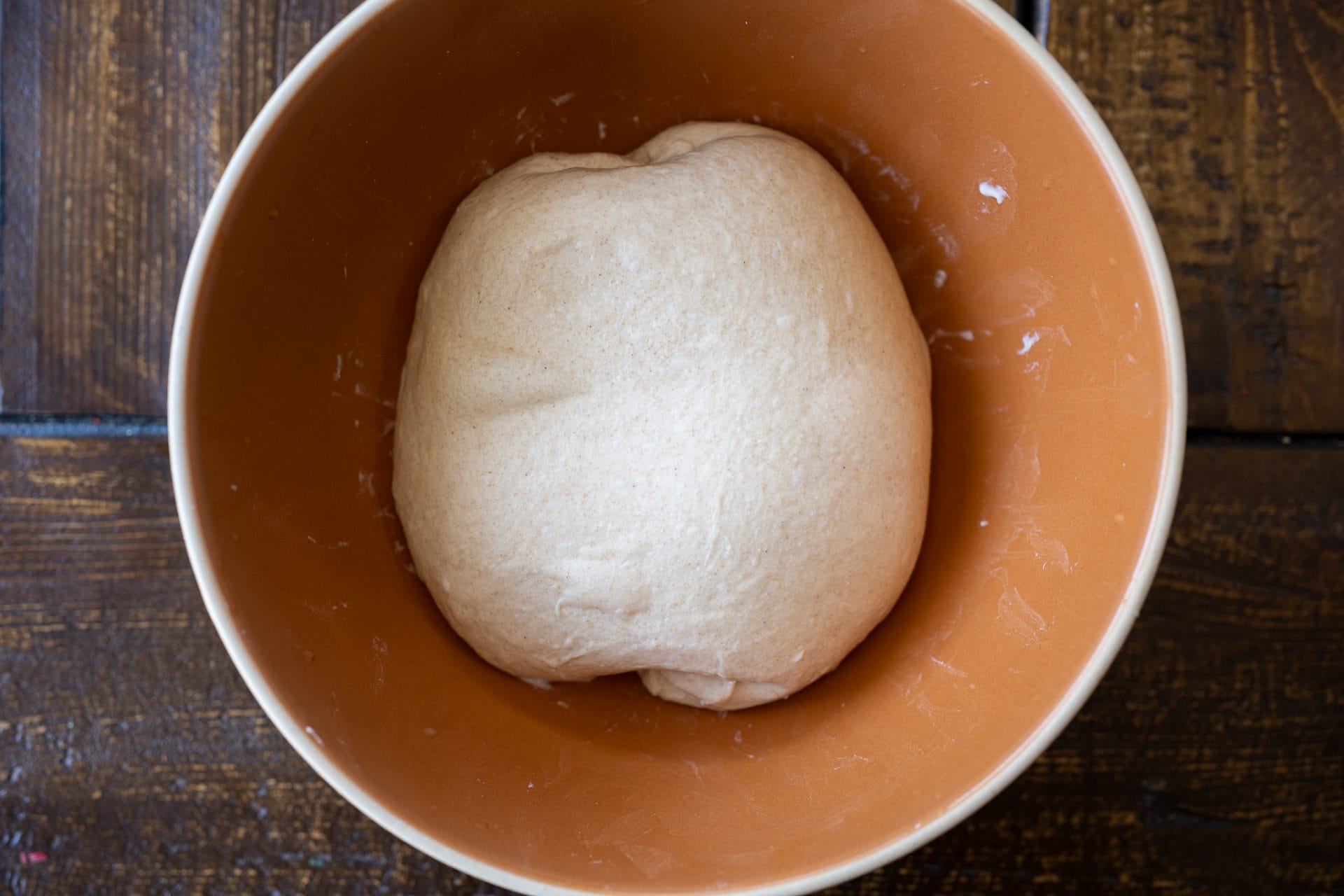
After the last set, cover the homemade hot dog bun dough and let it rest until the end of bulk fermentation.
3. Chill dough – 12:30 p.m. to 1:30 p.m.
Place the covered bulk fermentation container holding the dough into the refrigerator for one hour to chill the dough, which will make it easier to shape. If you're in a rush, you can skip this step and go straight to shaping, knowing it might be a bit more challenging (I've done it with no problem, though).
4. Divide and shape – 1:30 p.m.
Line a full sheet pan, or two half sheet pans, with parchment paper and set near your work surface.
Below you can see my dough after its 3-hour bulk fermentation and 1-hour in the fridge. It's well-risen, bubbly, and light, but it's also firm and cool to the touch.
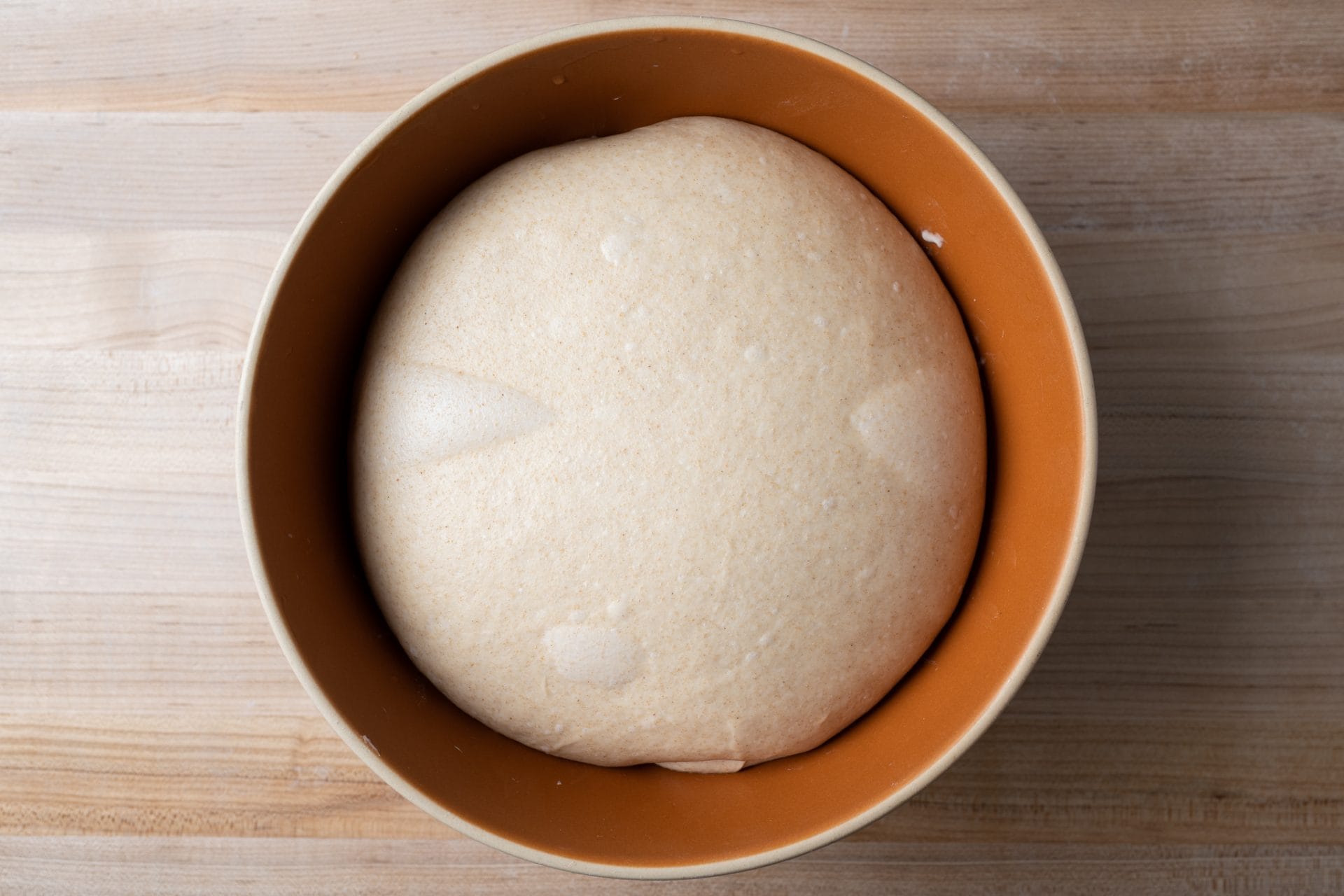
Remove the bulk fermentation container from the fridge, uncover, and lightly flour the top. Gently scrape the dough out to your work surface and divide it into ten pieces, each weighing 100g (you will have very little scrap dough left). It's best to try and divide the dough into small rectangles to make shaping easier.
To shape each piece of dough, begin by stretching or patting the piece into a rough rectangle with short sides to your left and right. Then, take the top edge (the farthest side from your body) and begin rolling it down toward your body. With each roll, press the dough into itself away from you, similar to how you'd preshape a pretzel. Continue to roll and press, roll and press, forming a tube. Once you've reached the bottom of the dough, seal the seam, and if the piece is a little squat, roll out a few times using the palm of your hand to elongate.
When each piece is shaped, place it on the prepared sheet pan with space between each piece. I like to stagger the pieces to allow for even airflow and prevent the eventual buns from touching, as you can see below.
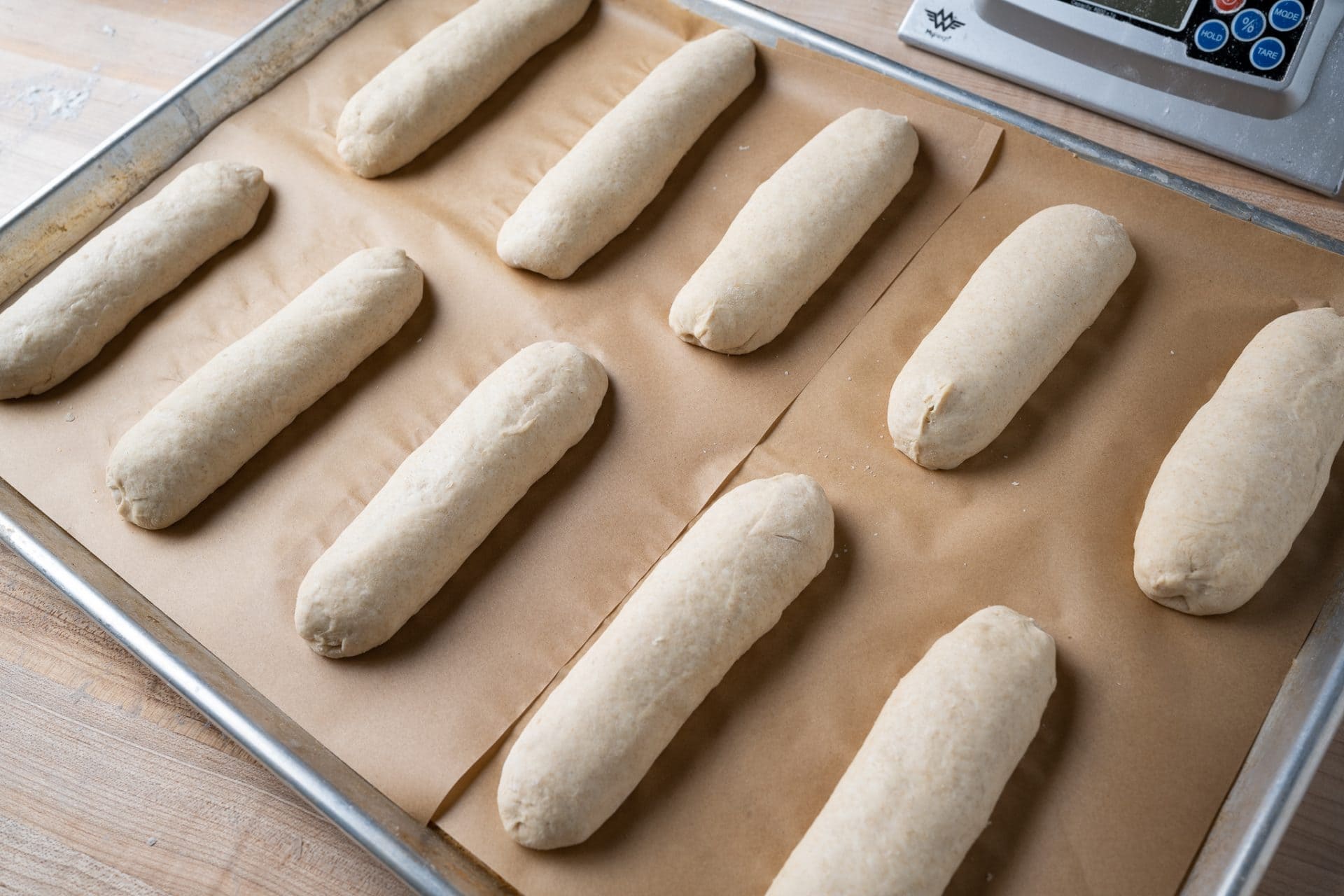
7. Proof – 1:45 p.m. to 3:45 p.m.
Cover the sheet pan with a large, reusable plastic bag and seal it shut. Let the dough proof on the counter for two hours (be sure to preheat the oven about 30 minutes before the end of this time).
8. Bake – 3:45 p.m.
Preheat an empty oven with a rack in the bottom-third to 425°F (220°C). In a small bowl, whisk one whole egg and one tablespoon of whole milk for the egg wash.
When the oven is preheated, uncover your fully proofed dough and brush on a thin layer of the egg wash. Slide the sheet pan into the oven and bake for 20 minutes—be sure to keep an eye on them near the end of this range, reducing the oven temperature if they color too fast.. After this time, rotate the pan back to front and reduce the oven temperature to 350°F (175°C). Bake for 10 minutes longer until the tops of the buns are golden brown, but the sides are still pale yellow.
Once fully baked, remove the buns from the oven and cool them on a wire rack for 15 to 30 minutes before slicing. These buns are fantastic buttered and grilled before serving.
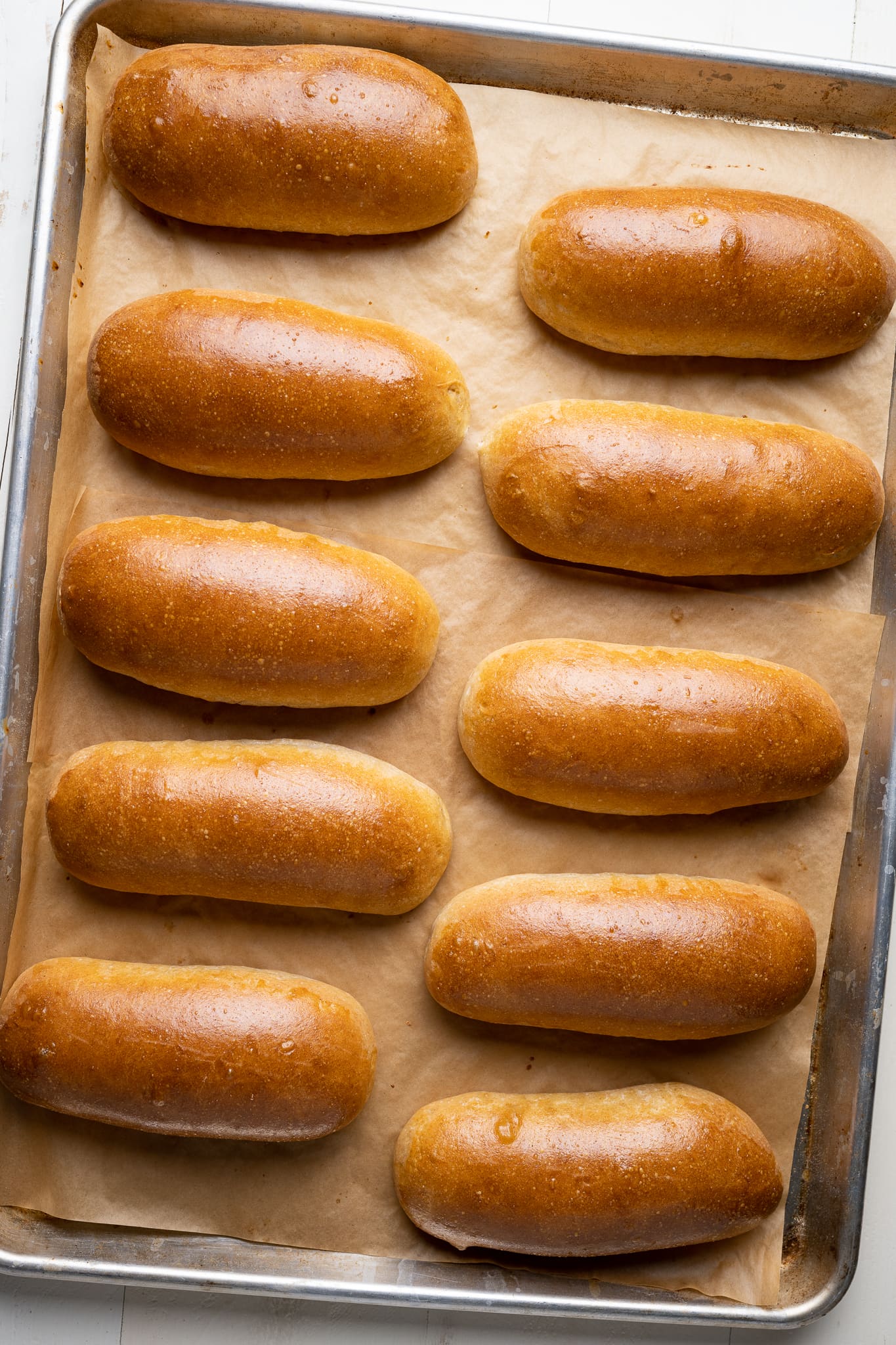
While making your own sourdough hot dog buns might seem like a tall order for such a humble food, but in terms of difficulty, I wouldn't say they're any more challenging than a good hamburger bun. What's more, the flavor and texture of these are leagues ahead of what you find at the market in a plastic bag. And regardless of how you cook your hot dog, with these homemade hot dog buns, your next summer gathering is sure to be even better than your childhood memories—but don't forget the water balloons. We're never too old for those.
Buon appetito!
Print
Homemade Hot Dog Buns
- Author: Maurizio Leo
- Prep Time: 6 hours
- Cook Time: 35 minutes
- Total Time: 6 hours 35 minutes
- Yield: 10 hot dog buns
- Cuisine: American
Description
Sturdy, light, airy, and absolutely delicious, these homemade sourdough hot dog buns will take your next hot dog to the next level.
Ingredients
Main dough
- 398g medium-protein bread flour or all-purpose flour
- 100g whole wheat flour
- 274g water
- 55g (one whole egg) egg
- 50g butter, unsalted
- 25g caster sugar
- 9g fine sea salt
- 139g ripe sourdough starter (100% hydration)
Egg wash
- 1 whole egg
- 1 tablespoon whole milk
Instructions
- Mix (9:00 a.m.)
Cut the butter into 1/2″ pats and let warm to room temperature while mixing the ingredients. In the bowl of a stand mixer fitted with the dough hook attachment, add the water, flour, sourdough starter, egg, sugar, and salt. Mix on speed 1 for 1 to 2 minutes until the ingredients come together. Increase the mixer to speed 2 and mix for 4 to 5 minutes until the dough starts to strengthen and clump around the dough hook. Let the dough rest in the mixing bowl for 10 minutes. Turn the mixer on to speed 1 and add the room temperature butter, one pat at a time, waiting to add each pat until the previous one is fully absorbed. This is a fairly strong dough, so it won't take long to add all the butter and the dough to come back together and smooth, somewhere around 3 to 5 minutes. - Bulk fermentation (9:30 a.m. to 12:30 p.m.)
Transfer the mixed dough to a bulk container and ferment for 3 hours at 75ºF (23°C). Perform 3 sets of stretch and folds at 30-minute intervals. - Chill dough (12:30 p.m. to 1:30 p.m.)
Place the covered bulk fermentation container into the fridge for at least 1 hour to thoroughly chill. - Divide and shape rolls (1:30 p.m.)
Line a full sheet pan, or two half sheet pans, with parchment paper and set near your work surface. Divide the dough into ten pieces, each weighing 100g. Shape each into a tube about 4-inches long and place them on the prepared sheet pan with space between. - Proof (1:45 p.m. to 3:45 p.m.)
Cover the proofing dough with a large, airtight cover ensuring the cover doesn't contact the dough (grease it with oil if necessary to prevent sticking). Let the dough proof at room temperature for two hours. - Bake (3:45 p.m.)
Preheat an empty oven with a rack in the bottom-third to 425°F (220°C). In a small bowl, whisk one whole egg and one tablespoon of whole milk for the egg wash. When the oven is preheated, uncover the dough and brush on a thin layer of the egg wash. Slide the sheet pan into the oven and bake for 20 minutes. After this time, rotate the pan back to front and reduce the oven temperature to 350°F (175°C). Bake for 10 minutes longer until the tops of the buns are golden brown, but the sides are still pale yellow. Once fully baked, remove the buns from the oven and cool them on a wire rack for 15 to 30 minutes before slicing. These buns are fantastic buttered and grilled before serving.
Notes
- These buns can be made New England-style by proofing them side-by-side in a single row on a full sheet pan.


